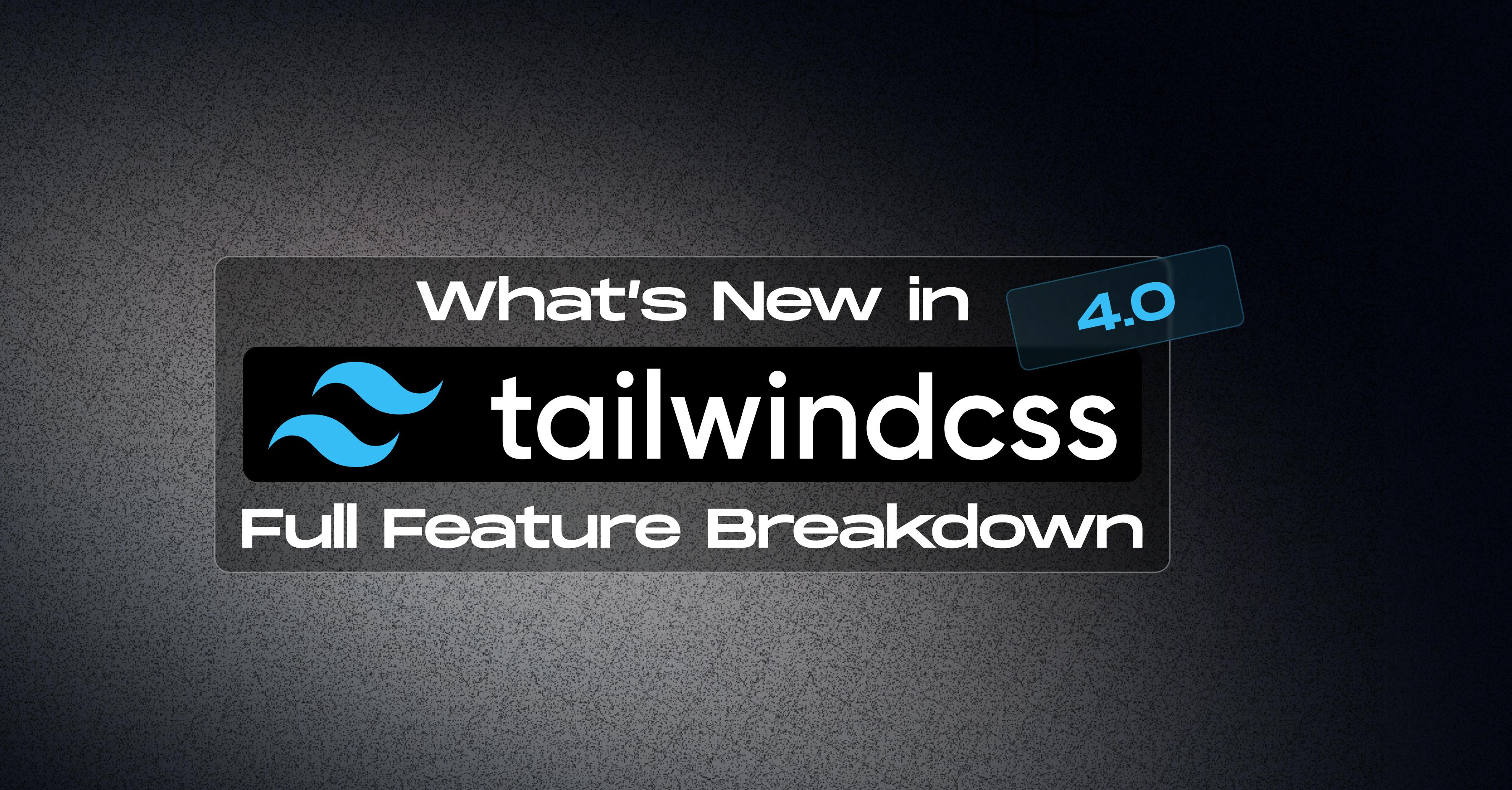May 19, 2025
What’s New in Tailwind CSS 4.0 – Full Feature Breakdown

Md. Saad

Welcome to the future of web styling with Tailwind CSS 4.0! This game-changing update to the wildly popular utility-first CSS framework is packed with cutting-edge features designed to supercharge your development workflow. Whether you're searching for Tailwind CSS 4.0 features, curious about the Oxide engine, or wondering how to migrate from Tailwind CSS 3, this article has you covered. With a blazing-fast Rust-based engine, Lightning CSS integration, composable variants, and a zero-configuration setup, Tailwind 4.0 is built for speed, simplicity, and modern web development.
Explore the new features, performance benchmarks, and practical examples that make this release a must-know for developers aiming to create responsive, accessible, and SEO-friendly designs. Ready to level up your projects? Let’s break down what’s new and how you can harness the power of Tailwind CSS 4.0 today!
A New Engine, Built for Speed
The new Oxide engine, which is the brains behind Tailwind CSS 4.0, was developed using Rust, a high-performance systems language renowned for its speed and security. Significant enhancements are brought about by this upgrade, including:
- Lightning-fast build times — up to 10x quicker than Tailwind v3
- More intelligent and effective CSS purging
- Complete support for multithreading to utilize every CPU core
- Smooth integration with Lightning CSS to improve preprocessing and compatibility
Tailwind 4.0 significantly improves speed and dependability by fusing Rust with a specially designed CSS parser.
Unified Toolchain with Lightning CSS
Lightning CSS is included with Tailwind 4.0, which simplifies setup and provides features like:
- @import support in CSS.
- auto-prefixing to improve compatibility across browsers.
- nesting in native CSS.
- compatibility with older browser versions.
Without having to set up several tools, you can develop more smoothly.
Built for the Modern Web
In addition to embracing contemporary CSS standards, Tailwind 4.0 adds new features like
- For improved style isolation, use cascade layers.
- CSS custom properties that support @theme.
- For more complex color manipulation, use color-mix().
- Container queries for layouts that are more flexible.
These improvements assist developers in producing designs that are accessible, responsive, and future-ready.
Composable Variants
One of Tailwind CSS 4.0's most developer-friendly features is Composable Variants, which makes combining state-based styles simpler and more natural.
@variants hover, focus, focus-within {
.btn {
background: violet;
}
}It enables you to design highly interactive user interface elements without using clumsy or repetitive class names.
Zero-Configuration Content Detection
You no longer need to manually define file paths in the configuration because Tailwind CSS 4.0 automatically recognizes the content you're styling (though that option still exists). Only the styles you use are generated thanks to this clever detection, which also expedites setup.
CSS-first Configuration
Tailwind CSS 4.0 encourages a CSS-centric configuration approach. Use @import, @theme, and CSS variables to style your project:
@theme {
--plugin-prefix: 'tw-';
--rounded-default: 0.5rem;
--ring-color: #34d399;
--font-size-headings: clamp(1.25rem, 4vw, 2rem);
}CSS-first config means less reliance on JavaScript and better alignment with browser-native features.
Key Changes from v3
Here are some important changes introduced in Tailwind 4.0:
- Deprecated utilities removed:
- text-opacity-* → use text-{color}/*
- flex-grow-* → use grow-*
- decoration-slice → replaced by box-decoration-slice
- CLI and PostCSS plugin split:
Install separately: @tailwindcss/postcss and @tailwindcss/cli - No default border colour:
Now uses currentColor instead of gray-200. - Ring utility update:
The default ring size is now 1px (was 3px), using currentColor. - No More tailwind.config.js file
One of the major simplifications in Tailwind CSS v4 is the removal of the default tailwind.config.js file. In previous versions (like v3), a tailwind.config.js file was typically generated to customize your Tailwind setup. In v4, Tailwind works out of the box using smart defaults — no config file necessary unless you need customization.
These refinements streamline the framework and prevent unintentional styles.
Migration Guide
Migrating to Tailwind 4.0 is straightforward:
1. Update Dependencies
npm uninstall tailwindcss postcss-cli autoprefixer
npm install tailwindcss@latest postcss@latest autoprefixer@latest
npm install @tailwindcss/postcss @tailwindcss/cli2. Adjust Your Configuration
- Deprecated utilities are removed.
- Switching to the PostCSS 8 plugin format
- Themes redesigned to make use of CSS variables
- The option to bypass the setup of content detection
3. Update Class Names
- Replace out-of-date utilities (flex-grow → grow, for example).
- Eliminate classes that are no longer supported.
4. Test & Debug
- Check for consistency in color, spacing, and responsiveness.
- Keep an eye out for any possible problems with the PostCSS or CLI setup.
- For comprehensive instructions, refer to the official migration guide.
For Vite Users: Switch to the New Vite Plugin
Tailwind now provides a dedicated Vite plugin for better integration and performance. Instead of using Tailwind through PostCSS, update your vite.config.ts as follows:
// vite.config.ts
import { defineConfig } from "vite";
import tailwindcss from "@tailwindcss/vite";
export default defineConfig({
plugins: [
tailwindcss(),
],
});Why the change?
This new plugin offers a faster and more reliable development experience by leveraging Vite’s native plugin API.
For CLI Users: Use the New Tailwind CLI Package
The Tailwind CLI has moved to its own dedicated package in v4: @tailwindcss/cli. Be sure to update your commands accordingly.
Old (v3):
npx tailwindcss -i input.css -o output.cssNew (v4):
npx @tailwindcss/cli -i input.css -o output.cssPractical Examples
Theming with CSS
@theme {
--ring-color: #34d399;
--font-size-headings: clamp(1.25rem, 4vw, 2rem);
}
h1, h2 {
font-size: var(--font-size-headings);
}Component Layers
@layer components {
.btn {
@apply bg-blue-500 text-white;
}
}Utilities Layer
@layer utilities {
.text-shadow {
text-shadow: 2px 2px black;
}
}Container Queries
.sidebar {
width: 20%;
}
@container (min-width: 800px) {
.sidebar {
width: 15%;
}
}Performance Benchmarks
Tailwind 4.0 delivers significant performance boosts:
| Metric | V3 | V4 | Improvment |
|---|---|---|---|
| Tailwind site build |
960ms |
105ms |
~10× faster |
| Catalyst UI Kit build |
341ms |
55ms |
~6× faster |
| Engine size |
421KB |
271KB |
35% smaller |
| CSS parsing |
Standard |
Custom >2× |
Faster |
The new Oxide engine is purpose-built for speed, and purging/minification is now dramatically
Community and Resources
With more than 50 user-suggested enhancements incorporated into the release, Tailwind CSS 4.0 was shaped by extensive community testing and feedback. Additionally, contributions improved theme customisation tools and TypeScript support.
The Tailwind team has made a number of official learning resources available to assist developers:
- Guide to Migration from Version 3 to Version 4
- Cheat Sheet for Tailwind v4.0
- Revised Tailwind Documentation
Conclusion
Ready to transform your projects with Tailwind CSS 4.0? This utility-first CSS framework delivers unmatched speed with the Oxide engine, seamless Lightning CSS integration, and powerful composable variants. From zero-configuration setup to responsive design and SEO-friendly features, Tailwind 4.0 empowers developers to create modern, accessible websites effortlessly. Curious about migration from Tailwind CSS 3 or exploring performance benchmarks? Dive into this game-changer and supercharge your workflow today! Have questions? Connect with experts to unlock Tailwind’s full potential!
StaticMania is a leading web development and design agency renowned for crafting innovative, high-performance websites across any tech stack. With expertise in Tailwind CSS, React, Vue, Node.js, and more, our team delivers responsive, SEO-friendly, and user-centric solutions tailored to your needs.
Whether you’re leveraging Tailwind CSS 4.0’s Oxide engine or building complex applications, StaticMania’s skilled developers ensure seamless integration, stunning designs, and optimised performance. Trust us to elevate your digital presence with cutting-edge technology and unparalleled expertise. Contact StaticMania today!
FAQs Tailwind CSS 4.0
The Oxide engine, built with Rust, powers Tailwind 4.0, offering up to 10x faster build times and multithreading support.
No, Tailwind 4.0 works without a tailwind.config.js file using smart defaults, but customisation is still possible.
Lightning CSS is integrated for simplified setup, supporting features like @import, auto-prefixing, and CSS nesting.
Update dependencies, switch to the new PostCSS 8 plugin, adjust class names, and test for consistency. Refer to the official migration guide.
Composable variants allow combining state-based styles (e.g., hover, focus) for interactive UI elements without complex class names.
It offers ~10x faster builds, 35% smaller engine size, and faster CSS parsing with the Oxide engine and Lightning CSS.

